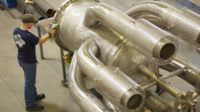Four decades is a long time in the life of any individual, organization, or industry. When it comes to a highly technical field such as metrology, however, 40 years might as well be an eternity.
In 1984, state-of-the-art measurement equipment included theodolites and photogrammetry systems. Coordinate measuring machines were just beginning to establish a presence at major manufacturers, but their remarkable levels of precision were only accessible in highly controlled cleanroom-type enclosures far from where manufacturing, assembly, and R&D applications were performed. Computerized data analysis was in its infancy.
Today, metrology has led the way to levels of productivity and efficiency that the engineers and manufacturing executives of 1984 could hardly have imagined. Portable metrology systems with single-micron levels of accuracy allow parts to be rapidly measured and inspected where the work is done. Radical advances in software allow acquired data to be analyzed and information applied to improve processes in increasingly sophisticated ways.
Measurement systems like laser trackers, laser radar, photogrammetry, articulated arm portable CMMs, and structured light scanners help power smart factories, creating ever-higher levels of efficiency and throughput for advanced manufacturers in sectors like aerospace, automotive, electronics, shipbuilding, medical device, and many more.
As executive committee chair of the Coordinate Metrology Society in addition to my day job as a manager and long-time user of metrology systems at HII-NNS, I’ve been privileged to personally witness a number of these forward leaps. Our hardware has gotten smaller, more robust, more accurate, and easier to use. Software interfaces are increasingly intuitive and the data more accessible. Our society’s annual conference, the CMSC, began in 1984 and I’m proud to say that our members have spearheaded many of these advancements since then. These members, made up of users, vendors, researchers, and educators, have a passionate commitment to finding production bottlenecks and developing the tools to solve those issues. That, in turn, often leads to uncovering further issues and discovering more solutions, in a virtuous cycle of continuous improvement that has taken us to something approaching a golden age in manufacturing.
So, what will the next 40 years bring? With the knowledge that it’s a lot easier to be accurate with a laser tracker as opposed to a crystal ball, I would hazard a guess at three key predictions for the future of metrology:
- Data will filter into information. There are already mountains of data being generated by smart factories across the world every second of every day. The trick is, and will increasingly be, to use machine learning to filter out the few ultra-important pieces of relevant, actionable information that most affects a manufacturer’s key processes—and then automatically apply those lessons learned into the workflow.
- Automation will be everywhere. Speaking of automation, it will spread from assembly cells to metrology applications, with test and measurement equipment embedded into robotic machinery that will test, measure, and assemble automatically in one station. One hundred-percent inspection will be widespread with little or no loss of throughput.
- There will be more work, not less. Although there’s much doom-and-gloom about these automated systems taking jobs away from human beings, history tells us that technological advancements always open more, not less, work opportunities—not to mention better ones. The need for design and programming will be intense, and although some of this could be automated as well, machines designing machines has a bit too strong of an Arnold Schwarzenegger vibe for me to see it as a realistic possibility.
Discussing issues like these is the bread-and-butter of the Coordinate Metrology Society. If you’re not a member, we invite you to visit us online and consider joining us at CMSC 2024. The conference is coming up in Charlotte, NC, from July 22–25. You can learn more and register here.




